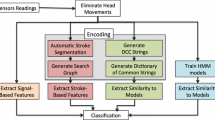Abstract
Purpose
Surgical processes are generally only studied by identifying differences in populations such as participants or level of expertise. But the similarity between this population is also important in understanding the process. We therefore proposed to study these two aspects.
Methods
In this article, we show how similarities in process workflow within a population can be identified as sequential surgical signatures. To this purpose, we have proposed a pattern mining approach to identify these signatures.
Validation
We validated our method with a data set composed of seventeen micro-surgical suturing tasks performed by four participants with two levels of expertise.
Results
We identified sequential surgical signatures specific to each participant, shared between participants with and without the same level of expertise. These signatures are also able to perfectly define the level of expertise of the participant who performed a new micro-surgical suturing task. However, it is more complicated to determine who the participant is, and the method correctly determines this information in only 64% of cases.
Conclusion
We show for the first time the concept of sequential surgical signature. This new concept has the potential to further help to understand surgical procedures and provide useful knowledge to define future CAS systems.






Similar content being viewed by others
References
Jannin P, Raimbault M, Morandi X, Gibaud B (2001) Modeling surgical procedures for multimodal image-guided neurosurgery. In: Niessen Wiro J, Viergever Max A (eds) Medical image computing and computer-assisted intervention MICCAI 2001. Number 2208 in lecture notes in computer science. Springer, Berlin, pp 565–572
Lalys F, Jannin P (2013) Surgical process modelling: a review. Int J Comput Assist Radiol Surg 9(3):495–511
Reiley CE, Hager GD (2009) Task versus subtask surgical skill evaluation of robotic minimally invasive surgery. In: Medical image computing and computer-assisted intervention MICCAI 2009. Lecture notes in computer science. Springer, Berlin, Heidelberg, pp 435–442
Despinoy F, Bouget D, Forestier G, Penet C, Zemiti N, Poignet P, Jannin P (2016) Unsupervised trajectory segmentation for surgical gesture recognition in robotic training. IEEE Trans Biomed Eng 63(6):1280–1291
Neumuth T, Strau G, Meixensberger J, Lemke HU, Burgert O (2006) Acquisition of process descriptions from surgical interventions. In: Bressan S, Kng J, Wagner R (eds) Database and expert systems applications. Number 4080 in lecture notes in computer science. Springer, Berlin, pp 602–611
Padoy N, Blum T, Feussner H, Berger MO, Navab N (2008) On-line recognition of surgical activity for monitoring in the operating room. In: IAAI, pp 1718–1724
Padoy N, Blum T, Ahmadi S-A, Feussner H, Berger M-O, Navab N (2012) Statistical modeling and recognition of surgical workflow. Med Image Anal 16(3):632–641
Bouarfa L, Jonker PP, Dankelman J (2011) Discovery of high-level tasks in the operating room. J Biomed Inform 44(3):455–462
James A, Vieira D, Lo B, Darzi A, Yang G-Z (2007) Eye-gaze driven surgical workflow segmentation. Med Image Comput Comput Assist Interv MICCAI 2007:110–117
Ko S-Y, Kim J, Lee W-J, Kwon D-S (2007) Surgery task model for intelligent interaction between surgeon and laparoscopic assistant robot. Int J Assit Robot Mech 8(1):38–46
Lalys F, Bouget D, Riffaud L, Jannin P (2012) Automatic knowledge-based recognition of low-level tasks in ophthalmological procedures. Int J Comput Assist Radiol Surg 8(1):39–49
Forestier G, Lalys F, Riffaud L, Collins DL, Meixensberger J, Wassef SN, Neumuth T, Goulet B, Jannin P (2013) Multi-site study of surgical practice in neurosurgery based on surgical process models. J Biomed Inform 46(5):822–829
Huaulmé A, Voros S, Riffaud L, Forestier G, Moreau-Gaudry A, Jannin P (2017) Distinguishing surgical behavior by sequential pattern discovery. J Biomed Inform 67:34–41
Riffaud L, Neumuth T, Morandi X, Trantakis C, Meixensberger J, Burgert O, Trelhu B, Jannin P (2010) Recording of surgical processes: a study comparing senior and junior neurosurgeons during lumbar disc herniation surgery. Oper Neurosurg 67:ons325–ons332
Neumuth T, Wiedemann R, Foja C, Meier P, Schlomberg J, Neumuth D, Wiedemann P (2010) Identification of surgeon individual treatment profiles to support the provision of an optimum treatment service for cataract patients. J Ocul Biol Dis Inf 3(2):73–83
Cao C, MacKenzie CL, Payandeh S (1996) Task and motion analyses in endoscopic surgery. In: Proceedings ASME dynamic systems and control division. Citeseer, pp 583–590
Forestier G, Petitjean F, Senin P, Despinoy F, Jannin P (2017) Discovering discriminative and interpretable patterns for surgical motion analysis. In: Conference on artificial intelligence in medicine in Europe. Springer, Berlin, pp 136–145
Mitsuishi M, Morita A, Sugita N, Sora S, Mochizuki R, Tanimoto K, Baek YM, Takahashi H, Harada K (2013) Master-slave robotic platform and its feasibility study for micro-neurosurgery: master-slave robotic platform for microneurosurgery. Int J Med Robot Comput Assist Surg 9(2):180–189
Garraud C, Gibaud B, Penet C, Gazuguel G, Dardenne G, Jannin P (2014) An ontology-based software suite for the analysis of surgical process model. In: Proceedings of Surgetica’2014. Chambery, France, pp 243–245
Sokal RR, Michener CD (1958) A statistical method for evaluating systematic relationships. Univ Kans Sci Bull 28:1409–1438
Process mining and automated process discovery software for professionals—fluxicon disco. URL https://fluxicon.com/disco/. Accessed 18 Dec 2017
Acknowledgements
This work was funded by ImPACT Program of Council for Science, Technology and Innovation, Cabinet Office, Government of Japan. Authors thanks the IRT b<>com for the provision of the software “Surgery Workflow Toolbox [annotated],” used for this work.
Author information
Authors and Affiliations
Corresponding author
Ethics declarations
Conflict of interest
The authors declare that they have no conflict of interest.
Ethical approval
All procedures performed in studies involving human participants were in accordance with the ethical standards of the institutional and/or national research committee and with the 1964 Helsinki declaration and its later amendments or comparable ethical standards.
Informed consent
This articles does not contain patient data.
Electronic supplementary material
Below is the link to the electronic supplementary material.
Rights and permissions
About this article
Cite this article
Huaulmé, A., Harada, K., Forestier, G. et al. Sequential surgical signatures in micro-suturing task. Int J CARS 13, 1419–1428 (2018). https://doi.org/10.1007/s11548-018-1775-x
Received:
Accepted:
Published:
Issue Date:
DOI: https://doi.org/10.1007/s11548-018-1775-x




